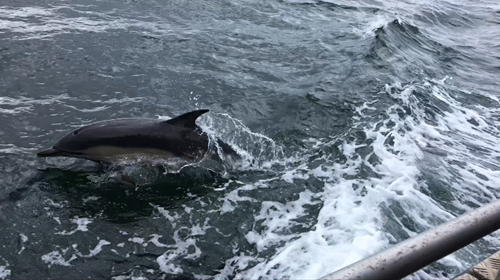The firth of Clyde is a saltwater inlet on the west coast of Scotland. It is home to thousands of harbour porpoises and a solitary Common dolphin nicknamed Kylie. Kylie spent a lot of her time near a buoy at the mouth of a loch called the Kyles of Bute which is how she earned her nickname (Cosentino et al., 2022).
Common dolphins are highly sociable creatures that live in large groups called pods so it’s extremely unusual for there to be a solitude individual. There are a few reasons why dolphins may end up on their own: they may get separated from their pod because of storms, human activity or be orphaned; it may also be the case that some dolphins are just not as sociable and prefer their own space (Brown, 2022).
Kylie was often seen around harbour porpoises which led people to believe she may be communicating with them. To test this theory acoustic recording studies were run three times throughout 2016 and 2017 when Kylie was around a harbour porpoise and when she was alone. Harbour porpoises produce high frequency clicks which is essentially the only sound they create, whereas common dolphins are more versatile when it comes to creating sound and are able to emit both clicks and whistles (Cosentino et al., 2022).
Dolphins create sounds by pushing air from their lungs through a similar structure to vocal cords humans have that are named the “monkey lips”. This is what creates their whistling sounds. In addition to whistling sounds dolphins can also make clicking sounds using their nasal cavities. Although dolphins only have one nostril, they still have both nasal cavities underneath the surface. The nasal cavity on the right is used for creating clicks that are responsible for commination and navigation. The nasal cavity leads to a fatty deposit on the dolphin’s head called the melon, which is responsible for amplifying and focusing the dolphin’s vocalisations (Brown, 2022). Previous research indicates that dolphins use whistling sounds as their primary means of communication. However, recordings of Kylie have shown no whistling sounds at all, only sounds similar to harbour porpoises (Yirka, 2022).
Porpoise clicks are called narrow-band high-frequency (NBHF) clicks which all species of harbour porpoises produce in addition to nine other species of cetaceans. The main features of the NBHF clicks are polycyclic waveforms (with 8 peaks at minimum), Gaussian-shaped envelope, concentrated energy between 100 and 150 kHz and a long prolongation (54-212 µs) (Cosentino et al., 2022).

Figure 1. Comparison. Left: Typical low-frequency click produced by Kylie. Middle: typical click produced by harbour porpoises. Right: High-frequency click produced by Kylie (recorded when seen alone). Top panels: waveform (amplitude is normalised using the clipping level of the hydrophone as the maximum value). Central panels: normalised power spectral density. Bottom panels: Smoothed Pseudo Wigner-Ville Distribution (FFT = 512, window size = 64, overlap 50%). (Cosentino et al., 2022)

Figure 2: Click train emitted by Kylie when she was seen swimming with a porpoise. The power spectrum shows the evolution from low-frequency, oligocyclic clicks to narrow-band, high-frequency, polycyclic clicks (Cosentino et al., 2022).
Imitation of vocalisations from different species has been observed mainly from animals kept in captivity as its easier to acoustically observe these animals than it would be in the wild. An example of this involves a captive beluga whale who learned how to imitate similar vocalisations to bottlenose dolphins only two months after being put into the dolphin enclosure (Cosentino et al., 2022). The beluga whale emitted whistles with similar frequency modulation patterns and stopped producing its traditional biphonic pulsed-tonal contact calls. This is similar to Kylie’s situation, as she exclusively emitted clicks and not whistles/different tonal sounds. In addition to this she also produced NBHF clicks when she was recorded on her own (Cosentino et al., 2022).
Kylie has been seen interacting with harbour porpoises in the Firth of Clyde for 14 years at least. The data collected by (Cosentino et al., 2022) indicates that she has been interacting with harbour porpoises more regularly than we previously thought; it also confirms kylie’s affiliation with the harbour porpoises. During the 14 years Kylie has been observed, she hasn’t been seen with other common dolphins which most likely means that she has had little to no contact with other common dolphins since becoming resident to the Firth of Clyde. The data also shows that Kylie can produce clicks that mimic harbour porpoise clicks, with both the frequency band where most of the concentrated energy is and the polycyclic waveform showing similarities to NBHF clicks (Cosentino et al., 2022).
Hannah McDowall Research Intern References Brown, E., 2022. For the first time, wild dolphin observed 'talking' with harbour porpoises. [online] National Geographic. Available at: <https://www.nationalgeographic.co.uk/animals/2022/03/for-the-first-time-wild-dolphin-observed-talking-with-harbour-porpoises> [Accessed 28 September 2022]. Cosentino, M., Nairn, D., Coscarella, M., Jackson, J.C. and Windmill, J.F., 2022. I beg your pardon? Acoustic behaviour of a wild solitary common dolphin who interacts with harbour porpoises. Bioacoustics, pp.1-18. Yirka, B., 2022. Researchers find dolphin attempting to communicate with porpoises. [online] Phys.org. Available at: <https://phys.org/news/2022-03-dolphin-porpoises.html> [Accessed 28 September 2022].

























